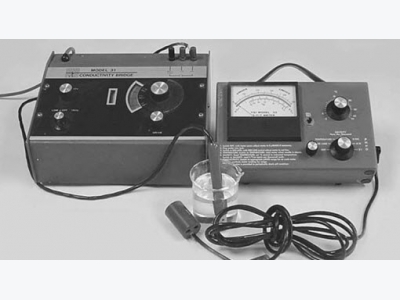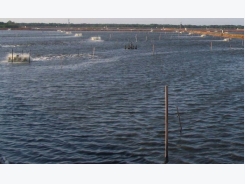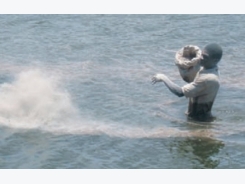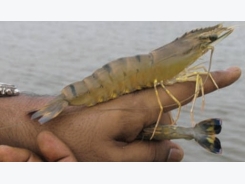Specific Conductance – Alternative Salinity Measurement

Most aquafarmers are accustomed to measuring the salin- ity of their production systems with salinity refrac- tometers. The refractive index of water changes in a pre- dictable way with increasing salinity. Salinity refractometers are calibrated so they provide direct readings of salinity.
Figure 1. Lab bench (left) and portable conductivity meters.
Salinity refractometers provide fairly accurate readings in water with 5 ppt salinity and above. However, they are less accurate at lower salinities. With shrimp culture in low-salin- ity water becoming common in many areas, more accurate ways of measuring low salinity will be necessary.
Conductivity and Salt Content
The ability of water to conduct electricity increases as the total concentration of dissolved ions increases. Thus, the measurement of conductivity provides a convenient way of estimating the salt content of water.
Conductivity can be determined accurately with con- centrations of ions ranging from those of dilute freshwater to those of full-strength seawater. These measurements can be made in situ quickly and accurately with portable con- ductivity meters, or water samples can be taken to a labo- ratory for conductivity measurements with bench-top con- ductivity meters (Figure 1)
Specific Conductance
Conductivity meters measure specific conductance, which is defined as the conductance afforded by a cubic mass of water with edges 1 cm long. Resistance in electrical circuits is reported in ohms. Conductance, the reciprocal of resist- ance, is reported as 1/ohms.
Thus, specific conductance could be given as 1/ohms- cm, but for convenience, it usually is given as mhos/cm. (Note the mho is “ohm” spelled backwards.) A 0.0100 nor- mal (N) potassium chloride solution* at 25° C has a specif- ic conductance of 0.001413 mho/cm.
*A 1.00 N solution of a substance contains 1 g equiva- lent weight of the substance/l. In the case of potassium chloride (KCl), 74.55 g KCl/l distilled water gives a 1.00 N solution.
To avoid small decimal numbers, it is customary to report specific conductance as micromhos/cm. A 0.0100 N potas- sium chloride solution has a specific conductance of 1,413 μmhos/cm at 25° C. Because potassium chlo- ride is used as a standard for specific conductance, the re- lationship between potassium chloride concentration and specific conductance is illustrated in Table 1.
Table 1. Concentration versus specific conductance for different potassium chloride solutions.
| Potassium Chloride | Specific Conductance | |
| Normality | mg/l | (μmhos/cm) |
| 0.0 | 0.0 | 0.0 |
| 0.0001 | 7.5 | 14.9 |
| 0.0005 | 37.3 | 73.9 |
| 0.001 | 74.6 | 147 |
| 0.005 | 373 | 718 |
| 0.01 | 746 | 1,413 |
| 0.05 | 3,728 | 6,668 |
| 0.1 | 7,455 | 12,900 |
| 0.5 | 37,275 | 58,640 |
| 1.0 | 74,550 | 111,900 |
Ion Concentration and Conductance
Ions have different capacities to convey electricity. For example, calcium ions convey more electrical current per equivalent than sodium ions, and potassium ions have a greater capacity to convey current than calcium ions. Water samples with identical total concentrations of salts can therefore have somewhat different specific conductances because concentrations of individual ions often differ among samples.
These discrepancies are not a major factor in considera- tions of specific conductance and salinity relationships in seawater or estuarine water, for their ionic concentrations are relatively constant in proportion. In fact, some conduc- tivity meters are calibrated to measure both specific con- ductance and salinity. The salinity measurement is based on extrapolation of salinity from the normal relationship between specific conductance and salinity in seawater.
Seawater-Specific Conductance
Normal seawater usually has a specific conductance of around 50,000 μmhos/cm. Its conductance increases with salinity, as shown in Figure 2.
Dissolved Solids and Salinity
Dissolved salts usually comprise over 95% of the weight of dissolved substances in natural waters, so total dissolved solids concentration and salinity should be ap- proximately equal. In seawater, total dissolved solids cannot be measured accurately because it is difficult to remove the water of hydration from the residual salts left after evapo- ration. In waters of 5 ppt salinity and less, however, total dissolved solids can be measured accurately, and the con- centration of total dissolved solids is approximately the same as salinity.

Figure 2. Relationship between salinity measured with a salinity refractometer and specific conductance in seawater diluted to different strengths with distilled water.
Dissolved Solids and Conductance
There is a close relationship between specific conduc- tance and total dissolved solids in samples of similar ionic proportions. This relationship allows meters to be calibrated to read total dissolved solids concentrations directly.
These conductivity meters are modified to display total dissolved solids instead of specific conductance. Specific conductance is converted to total dissolved solids concen- tration using a factor derived from the measured relation- ship between the two variables. This relationship is illustrated in Figure 3 for water from the Gila River in Arizona, USA. Unfortunately, for inland surface waters and ground wa- ters, ionic proportions often vary greatly among locations. The factor for converting specific conductance to total dis- solved solids concentration varies among waters from dif- ferent sources. Because of this, total dissolved solids meters do not provide results that can be compared among locations.
Temperature and Conductance
The specific conductance of a water sample will de- crease with decreasing temperature. Values can be adjusted to 25° C by dividing the measured conductance by the fac- tor 1 + [0.0191 water temperature – 25° C].
A sample with a specific conductance of 1,2103 μmhos/ cm at 22° C would have a specific conductance of 1,276 μmhos/cm at 25° C. Some conductivity meters have tem- perature compensators, but if your meter does not have one, failure to correct for temperature can cause small discrep- ancies in readings.

Figure 3. Total dissolved solids determined by water analysis compared with specific conductance of daily samples from the Gila River at Bylas, Arizona, USA over a 12-month period
Reference Points
Where conductivity meters are used to estimate the salt content of water, it is best to measure specific conductance directly and not attempt to convert the values to salinity or total dissolved solids. Some points for specific conductance:
• Distilled water usually has specific conductance of less than 2 μmhos/cm.
• In humid regions, inland surface waters seldom have specific conductance above 500 μmhos/cm.
• In semi-arid regions, specific conductance in inland surface waters can reach 4,000-5,000 μmhos/cm, while in arid regions, surface waters can have values above 5,000 μmhos/cm.
• Drinking water has specific conductance of 50-1,500
μmhos/cm.
• Inland shrimp production usually is done in waters of 2-5 ppt. This salinity range usually corresponds to specific conductance of 2,500-7,000 μmhos/cm.
• Seawater has an average specific conductance of around 50,000 μmhos/cm.
• A multiplier of 0.0006 is recommended for converting specific conductance (in mhos/cm) to salinity (in ppt) for inland ground and surface waters, while a multiplier of 0.0007 is recommended for brackish water and seawater.
Additional Conductance Measurement
A second method can also be used to report specific conductance values. Some conductivity meters display spe- cific conductance in millisiemens per meter (mS/m) ac- cording to the International System of Units. These values can be converted to μmhos/cm by the following relation- ship: 1 mS/m = 10 mhos/cm and 1 mS/cm = 1 μmho/cm. Thus, multiply mS/m by 10 to obtain μmhos/cm.
Conclusion
With activities like shrimp farming in low-salinity water becoming more common, more accurate ways of measur- ing low salinity are needed. Measurement of specific con- ductance is a valid alternative to salinity measurement by refractometry.
Có thể bạn quan tâm
Phần mềm

Phối trộn thức ăn chăn nuôi

Pha dung dịch thủy canh

Định mức cho tôm ăn

Phối trộn phân bón NPK

Xác định tỷ lệ tôm sống

Chuyển đổi đơn vị phân bón

Xác định công suất sục khí

Chuyển đổi đơn vị tôm

Tính diện tích nhà kính

Tính thể tích ao hồ




 Overview: Mechanical Pond Aeration
Overview: Mechanical Pond Aeration  Salinity Balance Key To Culture Success
Salinity Balance Key To Culture Success